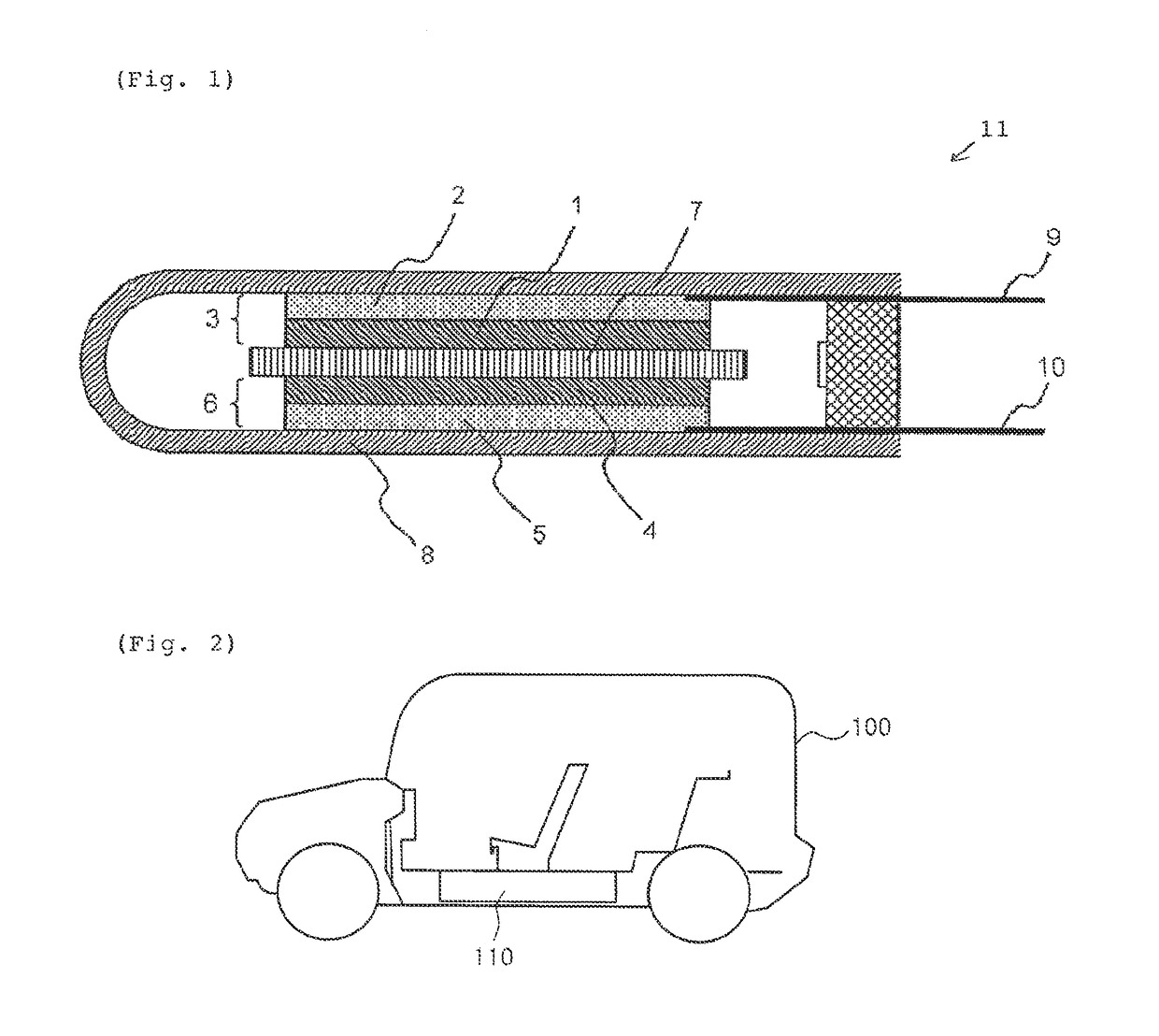Electrode binder for lithium secondary batteries, negative electrode for lithium secondary batteries using same, lithium secondary battery, automobile, method for producing electrode binder for lithium secondary batteries, and method for manufacturing lithium secondary battery
a lithium secondary battery and negative electrode technology, applied in the direction of electrode collector coating, lithium secondary battery, electrode binder for lithium secondary battery, etc., can solve the problems of increasing energy density, prolonging service life, and reducing cycle deterioration in charging/discharging, so as to prolong the service life of lithium secondary battery, suppress the deterioration of adhesive power, strength and stretchability
- Summary
- Abstract
- Description
- Claims
- Application Information
AI Technical Summary
Benefits of technology
Problems solved by technology
Method used
Image
Examples
example 1
[Preparation of Negative Electrode]
[0082]To a flask, 0.303 M of 4,4′-diphenylmethane diisocyanate (MDI), 0.300 M of anhydrous trimellitic acid (TMA) and 1400 g of N-methyl-2-pyrrolidone (NMP) were added and heated to 120° C. in about 3 hrs with stirring. Then 0.003 M of anhydrous phthalic acid was added and maintained at 120° C. for 5 hrs to give a solution in which a concentration of the polyamideimide represented by formula (3) (PAI-A, the number average molecular weight 41,000) obtained as a final polymer was 7 wt %.
[0083]
Using an artificial massive graphite powder having the average particle size of 20 μm, the average aspect ratio of 1.4 and the specific surface area of 1 m2 / g as a negative electrode active material, PAI-A, carbon black and carbodiimide (V02-B (isocyanate end-blocked) from NISSHINBO) at mass ratio of 89:9.9:1:0.1, a coating liquid for a negative electrode active material layer was prepared by dispersing these materials uniformly in N-methylpyrrolidone (NMP). Thi...
example 2
[0088]A laminate secondary battery was fabricated using the same method as in Example 1 except for preparing a coating liquid for a negative electrode active material layer in which the mass ratio of artificial massive graphite powder, PAI-A, carbon black and carbodiimide was changed to 89:9.5:1:0.5. The same charge / discharge cycle as in Example 1 was performed, and adhesion maintenance of a negative electrode active material layer was determined. The result is shown in Table 1.
example 3
[0089]A laminate secondary battery was prepared using the same method as in Example 1 except for preparing a coating liquid for a negative electrode active material layer in which the poly-amideimide (PAI-B, the number average molecular weight 42,000) represented by formula (4) obtained using 4,4′-oxydiphenyl diisocyanate was used instead of 4,4′-diphenylmethane diisocyanate (MDI). The same charge / discharge cycle as in Example 1 was performed, and adhesion maintenance of a negative electrode active material layer was determined. The result is shown in Table 1.
[0090]
PUM
| Property | Measurement | Unit |
|---|---|---|
| thickness | aaaaa | aaaaa |
| discharge terminal voltage | aaaaa | aaaaa |
| discharge terminal voltage | aaaaa | aaaaa |
Abstract
Description
Claims
Application Information
 Login to View More
Login to View More - R&D
- Intellectual Property
- Life Sciences
- Materials
- Tech Scout
- Unparalleled Data Quality
- Higher Quality Content
- 60% Fewer Hallucinations
Browse by: Latest US Patents, China's latest patents, Technical Efficacy Thesaurus, Application Domain, Technology Topic, Popular Technical Reports.
© 2025 PatSnap. All rights reserved.Legal|Privacy policy|Modern Slavery Act Transparency Statement|Sitemap|About US| Contact US: help@patsnap.com



